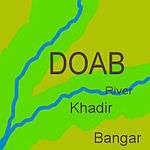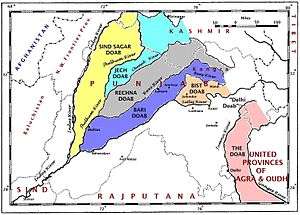Khadir and Bangar

Khādir or Khadar and Bāngar (Hindi language: खादर और बांगर, Urdu languageکهادر اور بانگر) are terms used in Hindi, Urdu, Punjabi and Sindhi in the Indo-Gangetic plains of North India and Pakistan to differentiate between two types of river plains and alluvial soils.
Khadir
Khadir or Khadar (Hindi: खादर) plains are those that are low-lying next to a river. Khadar areas are prone to flooding and sometimes include portions of former river-beds that became available for agriculture when a river changed course. It is moisture retentive and sticky when wet [1] Khadir soil consists of new alluvial soil deposits and is often very fertile. Bangar plains are more upland, and consist of older alluvial soil.
Bangar
Bangar (Hindi: बांगर) is not to be confused with sandy arid Bagar region which is also mainly not prone to the flood, but regions outside of Bagar region may have both Khadar and Bangar areas has both bangar and Khadar areas within same village (see Doab for better clarity). Bangar area are less prone to flooding but are usually more sandy and less fertile as well.[2][3]
Doab

Since North India and Pakistan are coursed by a multiplicity of Himalayan rivers that divide the plains into doabs (i.e. regions between two rivers), the Indo-Gangetic plains consist of alternating regions of river, khadir and bangar. The centers of the doabs consist of bangar and the peripheries, which line the rivers, consist of khadir.[4] Historically, villages in the doabs have been officially classified as khadir, khadir-bangar (i.e. mixed) or bangar for many centuries and different agricultural tax rates applied based on a tiered land-productivity scale.[5][6]
In some areas, these terms have become incorporated in several village names themselves, such as Murshidpur Bangar and Ranchi Bangar-Khadir in Mathura district of Uttar Pradesh.[7] Other places include Chilla Saroda Bangar, Gharonda Neemka Bangar, Pehlad Pur Bangar, Rampur Bangar and Salarpur Khadar.
See also
References
- ↑ Yash Pal Singh, भूगोल (Geography), VK Publications, ISBN 978-81-89611-21-7,
... मैदान के उस भाग को बांगर कहते हैं जहाँ नदियों की बाढ़ का पानी नहीं पहुंच पाता ... पुरानी जलोढ़ मिट्टी ... खादर: यह वह क्षेत्र है जहाँ नदियों की बाढ़ का जल प्रतिवर्ष आ जाता है ...
- ↑ Alexander Macaulay Markham, Report on the Tenth Revision of Settlement,
... The open plain country of Bijnour is, in common parlance, divided into two portions - 'Khadir' or low-lying land and 'Bangar' or upland ...
- ↑ Shahnaz Parveen, Changing face and challenges of urbanization: a case study of Uttar Pradesh, Concept Publishing Company, 2005, ISBN 978-81-8069-237-6,
... Lithologically and structurally, the Ganga-Yamuna Plain is divided into 'Bangar' and 'Khadar'. 'Bangar' spelled also as 'Bhangar,' is the part beyond the reach of flood waters and is composed of older alluvium of a dark colour of pale reddish brown ...
- ↑ Pakistan: Soils, Encyclopædia Britannica, 2010,
... khaddar soils. Away from the river, toward the middle of the doabs, older alluvial soils (called bangar) are widely distributed ...
- ↑ F.C. Channing, Land Revenue Settlement of the Gurgaon District, Government of India,
... The rates here applied were the same as those applied in the Bangar and Khadar circles and the same comparisons hold good ...
- ↑ Oswald Wood, R. Maconachie, Final report on the settlement of land revenue in the Delhi District, Government of India, 1882,
... The Khadar-Bangar chak lies along the river; 37 villages are purely Khadar and 39 partly Khadar partly Bangar. The villages nearest the river are subject to inundations, but where the water runs off in time, the natural fertility of the ...
- ↑ "मथुरा-वृंदावन पालिकाओं का अस्तित्व होगा खत्म (Mathura-Vrindavan municipalities will cease operations)", Dainik Jagran,
... मथुरा नगर पालिका सीमा में मुर्शिदपुर बांगर, औरंगाबाद बांगर, दामोदरपुरा बांगरपुरा, दामोदरपुरा खादर, रांची बांगर, रांची बांगर खादर, कोयला अलीपुर बांगर, खादर, बाद, आजमपुर, नवादा, तंतूरा, बिर्जापुर, नरहौली, महौली, पालीखेड़ा, वाकलपुर, गनेशरा, सलेमपुर, छरौरा, गिरधरपुर, ईशापुर, लोहवन, गौसना को जोड़ा जाएगा ...